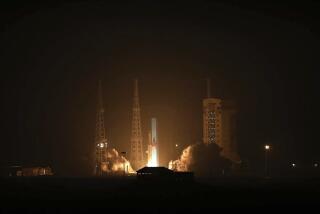Sabotaged Missile Launches? : Explosions, Key Air Force Officer’s Disappearance Probed
- Share via
In a departure from its public position, the French government has concluded that the explosion of its Ariane rocket at the Kourou launch site in French Guinea on May 30 may have been due to sabotage. According to French intelligence officials, the investigation into the Ariane accident has been secretly reopened because, “Initially we had no reason to raise the question of sabotage, but now we have reason to ask that question.”
France has shared its concerns and suspicions about Ariane with the highest levels of U.S. intelligence--French Defense Minister Andre Giraud is believed to have touched on this topic when he visited Washington last Tuesday and Wednesday--because of the series of catastrophes involving American space launches this year. The French and American accidents are adding up to a bizarre pattern, surrounded by strange coincidences and unexplained events, deeply preoccupying Western intelligence. These include the apparent defection to the Soviet Union in 1983 of the U.S. Air Force’s leading expert on rocket self-destruct procedures.
With the loss of the space shuttle Challenger on Jan. 28, a Titan 34-D rocket on April 18, a Delta rocket on May 3 and the French Ariane, all of which carried American reconnaissance satellites, the United States no longer has the capability of putting satellites into orbit to monitor Soviet nuclear deployments and serve as early-warning systems against a ballistic-missile attack. The Challenger and the Delta rocket were launched from Cape Canaveral in Florida, the Titan from Vandenberg Air Force Base in California. Before the string of 1986 losses, a Titan blew up at Vandenberg last August and an Ariane rocket exploded at Kourou in September.
Although specific causes of all these accidents varied in each case, according to technical inquiry reports, the common denominator was that most of the rockets--including the Challenger’s solid-fuel boosters--had to be destroyed by radio command from the ground to prevent debris from falling into inhabited areas.
In the case of Ariane, the technical report on the causes of the May 30 accident concluded that it was the failure of the rocket’s third-stage engine to ignite properly and propel the rocket into orbit that forced a loss of power and triggered the destruct order four minutes and 36 seconds after launch. The full text of this report is available only to Ariane’s potential payload customers. For example, it was presented on Wednesday to the Commerce Department and the National Aeronautics and Space Administration by Frederic d’Allest, the general manager of France’s National Center of Space Studies. But French intelligence officials say that while the report is technically correct (the 1985 Ariane accident had the same cause), “it is very easy to perform sabotage in this context by one very well-placed person.”
French intelligence officials declined to provide details concerning their new suspicions, but experts in this realm are fascinated and intrigued by a series of extraneous events that may have a bearing on the destruction of the West’s satellite launch capability.
By far the most interesting is the mysterious disappearance three years ago of a U.S. Air Force officer who specialized in space-launch command, control and communications for satellite surveillance systems. Capt. William Howard Hughes Jr., then 34 years old, was the “lead analyst” of the Command Control and Communication Surveillance Systems at the Air Force Operational Test and Evaluation Center at Kirkland Air Force Base in Albuquerque, N.M., which tests new space-related weapons systems. Among his responsibilities was the training of range officers in charge of destroying rockets malfunctioning after launch.
Hughes, who was single, was dispatched to the Netherlands on July 18, 1983, to work with North Atlantic Treaty Organization officers on the operations of AWACs electronic surveillance aircraft. He was due back in Albuquerque that Aug. 1. But after leaving for Europe, he was never seen again. On Dec. 9, 1983, the Air Force formally declared him a deserter.
Intelligence officers believe that Hughes was either captured by Soviet agents or voluntarily defected to the Soviet Union. At the time of his disappearance, the Air Force said that he had no classified materials with him. But these intelligence officers point out that Hughes’ knowledge of all the top-secret rocket launch procedures was invaluable to the Soviets, perhaps more so than the secrets delivered by recently captured spies. “He is worth his weight in gold to the Russians in terms of future ‘Star Wars,’ if we have them,” one said. They see a clear link between Hughes and possible sabotage of the American and French launches.
Another bizarre occurrence, neither explainable nor evidence of anything, was the sudden disappearance of Soviet trawlers from the Cape Canaveral area four hours before the scheduled launch of the Challenger on Jan. 28. The trawlers, which are electronic spy vessels, had been on station off the cape from the start of the U.S. space program. On that January morning, however, three or four trawlers steamed at flank speed in a northeastern direction away from the coast. Normally, these trawlers seek to monitor telemetric signals from the rockets before, during and after launch because they provide crucial data on the space vehicles’ performance--among the most avidly sought information by both the United States and the Soviet Union on each other’s ballistic arsenals. It is an absolute mystery why the trawlers, as observed by the U.S. Navy, went off station in this manner.
More to Read
Sign up for Essential California
The most important California stories and recommendations in your inbox every morning.
You may occasionally receive promotional content from the Los Angeles Times.










